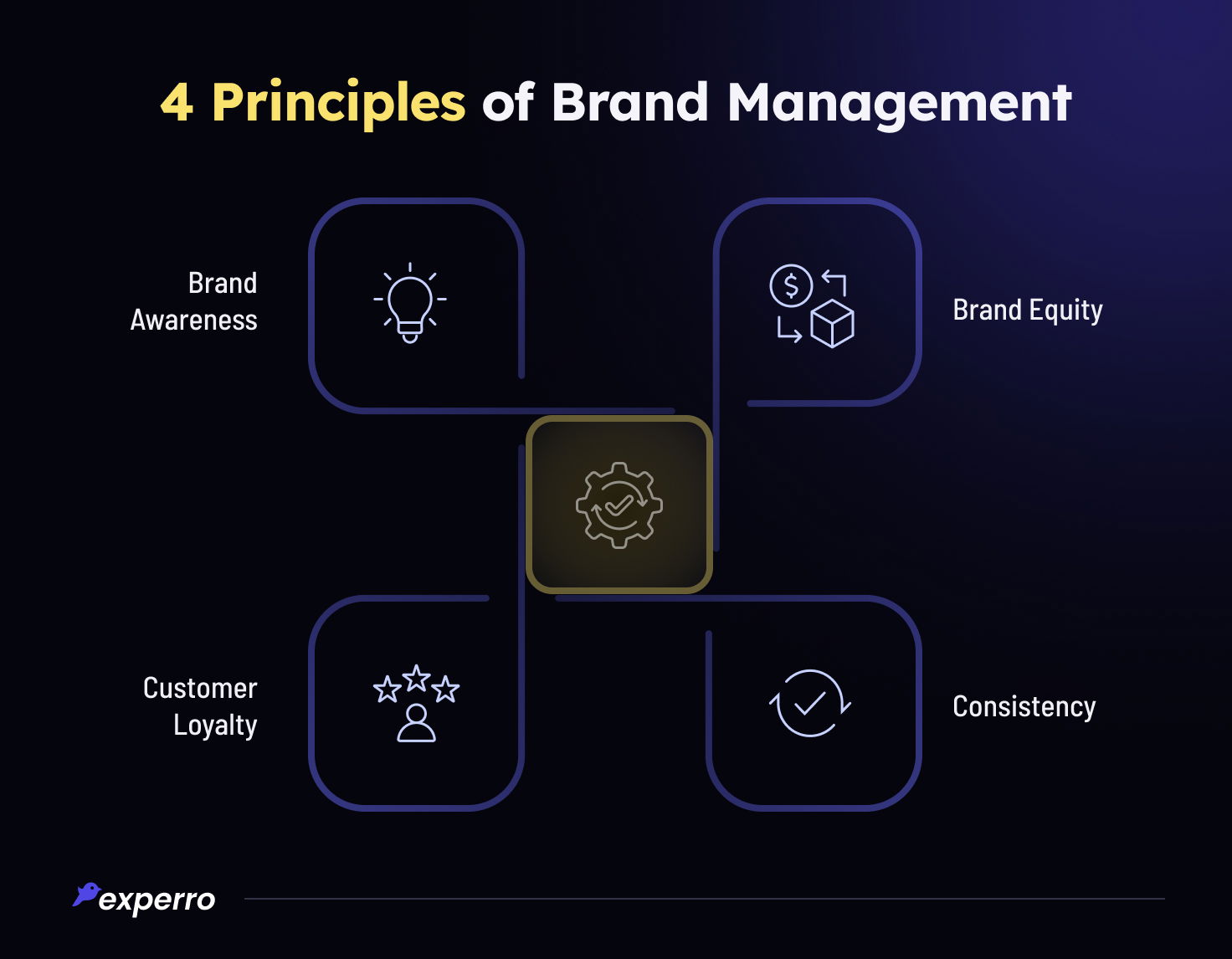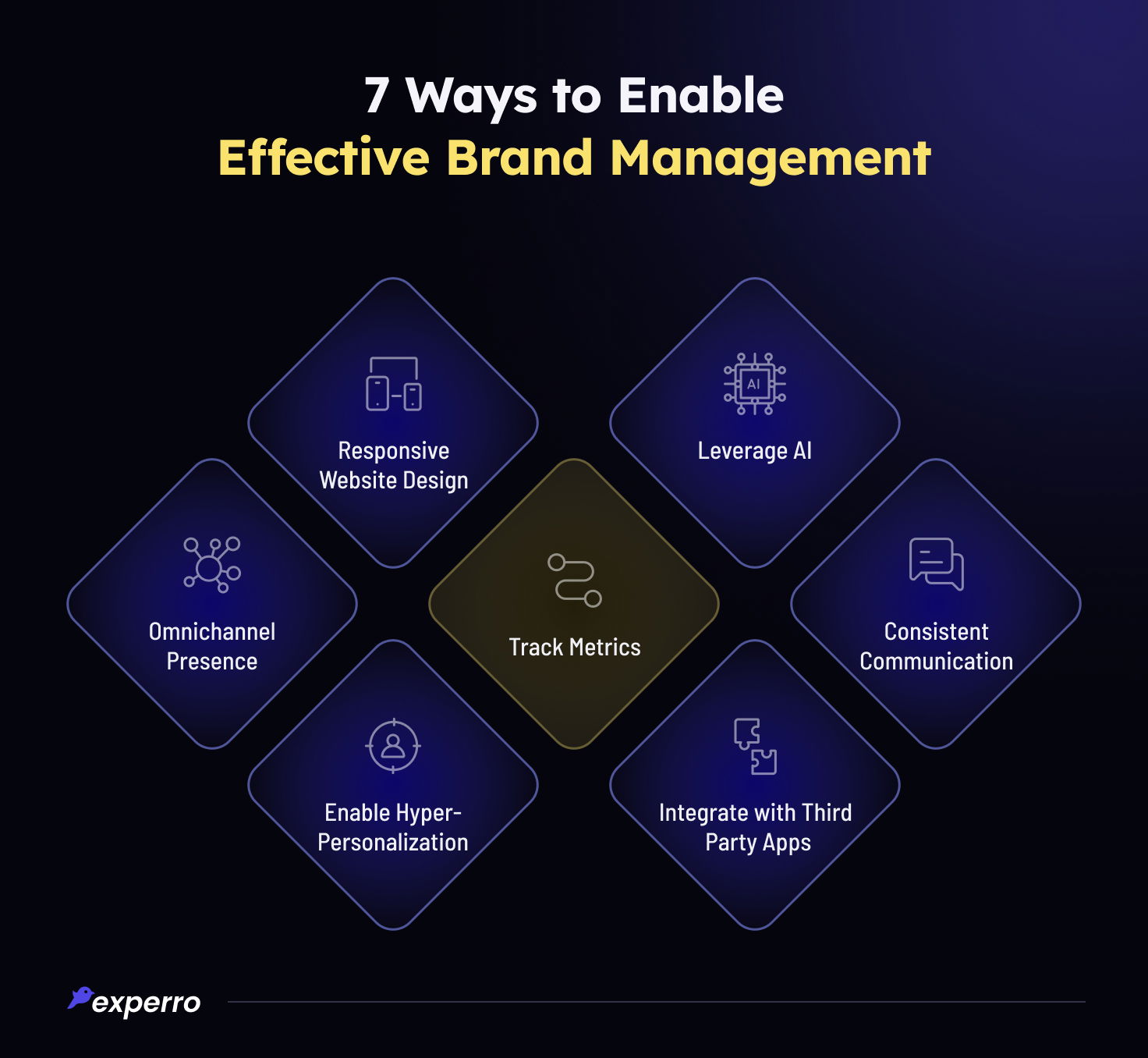- Blog
- Digital Experience
- Composable eCommerce
- 11 min read
What Is Brand Management - The Complete Guide!
Published
14 June 2024Updated
2 September 2025

Key Takaways
- Did you know? Two-thirds of the businesses say brand consistency has contributed to their revenue growth of 10%.
- The brand is not just your logo, website, or tagline; it's the experience you provide to your customers.
- Brands must be consistent in design, experience, and communication.
- Digital brand management plays a crucial role in shaping perceptions and maintaining consistency.
- Effective brand cultivation sets the brand apart from competitors by maintaining its unique identity.
The way people perceive your brand matters! Every click and scroll is crucial if you want to build a connection with a user and aspire to shape a positive brand image.
Whether it’s a brick-and-mortar store, website, social media, or mobile app, your brand should be able to provide the same value and maintain its unique voice.
However, organizations may find it challenging to keep up with changes and consistently maintain their identity.
That is where brand management comes into the picture! It ensures consistent, compelling, and strategically aligned brand representation across all digital touchpoints.
If you are a brand manager, marketer, or entrepreneur looking to enhance your company's brand image, you are at the right place.
In this blog, we will explore what is brand management, how to enable it, and tips on effective brand management strategies.
What Is Brand Management?
Brand management definition according to Gartner - Brand management is the integrated plan designed to guide a brand to achieve specific objectives.
Establishing a brand is exciting, but the job doesn't end here. The real task lies in how marketers maintain a unique brand voice and make it stand out in a crowded marketplace.
The brand management process enhances a brand’s identity through design, consistent communication, and focus on creating an exceptional customer experience.
It involves strategies to develop brand awareness, build positive brand perception, and loyalty. Especially in today’s dynamic digital marketplace where choices are abundant, standing out is paramount for organizations.
So, branding management is not just a strategy but a process that enhances awareness, equity consistency, and loyalty.
We at Experro believe brand management strategy goes beyond marketing and even transactions. It's about building an emotional connection with the audience.
The goal is to make your brand synonymous with certain feelings, experiences, or moments in people's lives.
For instance, when you hear ‘I'm Lovin' It', what pops up in your mind first? For most, it instantly evokes images of McDonald's!
At its core, it’s all about consistently crafting and maintaining brand perception in the marketplace and providing a memorable customer experience!
Now that you know what is brand management let's dive into its importance.
Importance of Brand Management
- Brand consistency can increase revenue by 20%.
- Online brand management helps businesses to build a strong and reliable brand image.
- Effective brand management enables loyalty among customers.
- Implementing strong brand governance increases customer confidence and ensures consistent quality and reliability.
- In the competitive market, distinct brands and entities are the key differentiators to attract customers.
- Brand management is not a luxury, but a strategic approach business adopts for long-term success.
4 Principles of Brand Management

Branding management is built on specific principles that explain how brands are managed effectively. From the time customers discover your brand until they become loyal customers, every interaction matters.
These principles help build and enhance the overall customer experience. The four principles of brand management are as follows:
1. Brand Awareness – Where Customers Get to Know the Product
Creating brand awareness is the first step of the brand management process. Several brands in the market operate within your niche.
However, if you want to differentiate your brand and stand out in the crowded marketplace, the first step is to let your target market know your presence.
This stage is called awareness, where the customer learns about you for the first time.
In the brand awareness stage, you are not only making the audience aware of your brand, but you convince your users to be the buyers.
Marketing teams can create brand awareness through effective communication and high-quality content.
Enabling content first marketing strategy using headless CMS is a great way to build awareness and positive perception of the brand.
Imagine a notification of tailored content appearing on your phone related to a product you recently searched for. Such personalized content, resonating with your interests, encourages you to delve deeper and potentially make a purchase.
TIP – A headless content management system can aid marketers by offering tools to plan, create, and distribute content effectively and help to build strong brand awareness.
2. Brand Equity – Build Positive Reputation
Simply producing content isn't sufficient. The real challenge for marketers is ensuring that users find the content satisfactory and enjoy it.
This leads us to the second principle: equity. This phase aims to deliver an exceptional customer experience while establishing a strong brand reputation.
Ask the following questions:
- Is your online presence creating a positive buzz out there?
- Is your website getting enough traffic through marketing efforts?
- Are your users happy with the content you’re publishing?
Marketers can find the answer to these questions through data in Analytics features.
TIP - Brands must create quick and customer support to build a positive reputation. Quick content updates in positive customer experience that win the audience's heart always benefit the brand.
3. Consistency – Maintaining a Consistent Brand Image
Consistency is the key to a successful brand management strategy.
In the era of multiple digital touchpoints, marketers have a bigger responsibility on their shoulders. The responsibility is that they must ensure a consistent user experience over different digital channels and devices.
No matter which digital channel a customer uses, they should have a similar qualitative user experience.
For instance, if a customer discovers a product from the Instagram page and carries forward the purchase through the company website, then the user experience must be consistent.
Similarly, even if customers use a smartphone desktop or a tablet, they should encounter a uniform layout of the brand’s website.
4. Customer Loyalty – Fostering Long Term Relationships
A total of 59% of American consumers say that once they’re loyal to a brand, they’re loyal to it for life.
Brand loyalty refers to creating a valuable brand image where customers return to you for purchase. While attracting customers might be straightforward, retaining them can be a tougher challenge. Notably, the cost of acquiring a new customer often surpasses the cost of retaining a customer.
Loyal customers tend to repeat purchases. This results in higher lifetime value, making acquiring that customer more worthwhile.
Additionally, customer loyalty spreads a positive word of mouth - the most effective marketing strategy. Here, your customers become your brand ambassadors and increase brand recognition.
How to Enable Effective Brand Management?

The points mentioned below highlight how organizations can enable effective brand management.
1. Responsive Website Design
Did you know? It takes 0.5 seconds for people to form an opinion about your website. After all, the first impression matters!
Websites are the first point of interaction for your users. A website holds the power to make or break the brand image. It's like a window to your brand's online presence.
Imagine, users visiting your website and struggling with cluttered content and irresponsive interface that doesn't adapt with their device. They will probably leave the website without even further discovering products.
The key here is to create an exceptional customer experience with a fast and beautiful website. Creating a high-performance website includes fast loading times, responsive designs, and mobile-first experiences.
To build such an exceptional customer experience with a beautiful and fast website, check out Experro's website builder.
2. Leverage AI
According to the Techjury 35% of companies are using AI, and 42% of companies are exploring AI for its implementation in the future.
Staying ahead with the latest innovations is important in the dynamic digital landscape. AI is weaving its magic everywhere. From voice assistance to self-driving cars, it is reshaping the experiences.
So, why not use this transformative approach in websites?
Leveraging AI is undoubtedly an effective brand management strategy to enhance customer experience.
For instance, Experro's AI-powered search understands customers' search queries and helps them navigate the products better.
Let's understand how it works from the example below:
A shopper begins to type "sneak" into an eCommerce platform's search bar. Thanks to the auto-complete feature, before she even finishes typing, the system offers suggestions such as "sneakers for running," "sneaker cleaning kit," and "sneakers in white color."
This not only speeds up the search but also offers insights into other relevant products shoppers might not have initially considered.
3. Omnichannel Presence
Brands with omnichannel engagement see a 9.5% increase in annual revenue. Customers prefer a consistent user experience over an Omnichannel presence.
Omnichannel content distribution using headless CMS helps to create a seamless experience for customers.
By providing multiple options for purchase, customers can effortlessly transition between online and offline platforms according to their convenience.
This journey builds a positive perception of your brand. Additionally, being present on multiple channels gives a deeper understanding of consumer behavior. The information can be leveraged for better brand management and to provide a better customer experience.
4. Track Metrics
Tracking metrics provides valuable insights into how your audience engages with your brand. It shows valuable data and insights on consumer behavior, website visits, and engagement rates.
According to these metrics, brand managers can identify how well the brand is performing in the market and manage brand proficiently.
For instance, marketers can measure bounce rates, conversion rates, and more. It enables marketers to take a data-driven approach and helps them to make informed decisions based on consumer behavior.
5. Consistent Communication
Consistent communication is an essential part of brand management. Customers who interact with your brand through our website, social media, or mobile application should have a cohesive experience. Consistent communication helps to manage brand effectively.
Creating consistent experience includes everything from the tone of voice content, product or service information, and visual elements like logos. Creating uniformity in these aspects helps consumers to identify the brand instantly.
6. Enable Hyper-Personalization
Did you know? 80% of the consumers prefer to buy from a company that provides a tailored experience.
Personalize, delight, repeat!
Effective brand management always includes hyper personalization in the branding strategy.
Brands can take personalization to the next level by delivering highly tailored content according to users' requirements. This means understanding each customer’s preferences, behavior, and needs granularly.
7. Integrate with Third Party Apps
Integration with other 3rd party apps streamlines the workflow process and enhances the customer experience. For instance, integrating your brand with your favorite CRM tool allows you to keep a centralized record of customer interaction.
Additionally, integrating with your favorite SEO tool can help to optimize content for search engines and get discovered by your target audience easily.
4 Brand Management Tips to Build Lasting Impression
The points mentioned below highlight the vital digital brand management tips:
Take Data-Driven Decisions
Valuable customer data is like a gold mine of insights.
Making data-driven decisions in brand management involves leveraging customers' information to understand their behavior preferences and emerging market trends.
For example, an eCommerce platform notices a surge in traffic for a particular personalized product recommendation. They can use this information to revamp marketing efforts and product availability for future demand.
The data-driven approach leads to more accurate information about the market requirement and forecasting of consumer behavior and helps to implement brand management strategies effectively.
Effective Digital Asset Management
Asset management is an important aspect of brand management services. Digital asset management includes managing all the content within organizations, such as image videos, logos, and content representing the brand's identity.
Effective creative asset management ensures these resources are organized, accessible, and used consistently across all channels.
Centralized Control
Centralized brand control is essential for maintaining consistent brand communication. It streamlines brand management process and builds a strong identity. Centralized brand control involves establishing clear brand guidelines and providing a centralized content repository platform to access all digital assets.
Want to Deliver a Consistent Branding Experience?
Conclusion
Effective brand management services is the guiding force that shapes how the brand is perceived in the marketplace, influencing consumers’ decision-making journeys and ultimately generating sales.
The importance of brand management cannot be overlooked in today's competitive era. Brand management enhances the brand's identity and unlocks its fullest potential in the market.
A headless content management system helps brands to effortlessly tailor the content for different devices and deliver it consistently. Eventually, it crafts the experience that resonates, attracts, and converts.
To create such an experience for users and manage brand effectively, book a call with Experro today!
FAQs
What is the difference between marketing and brand management?
Marketing consists of promoting products or services to generate sales. On the other hand, brand management process focuses on shaping and maintaining the brand's perception by providing the best possible customer experience.
What is the role of brand management services?
The role of brand management services is to strategically develop and maintain brand identity and stand out in the marketplace with a unique approach. The aim is to build the brand reputation and foster trust among customers.

Priya Zala
Content WriterThrough her writing, she has a lovely way of capturing users' pain points and delivering solution-oriented content. Her writing is sure to captivate readers and leave them with a lasting impression. When not crafting content, Priya enjoys getting lost in a good work of fiction, which soothes her soul.


